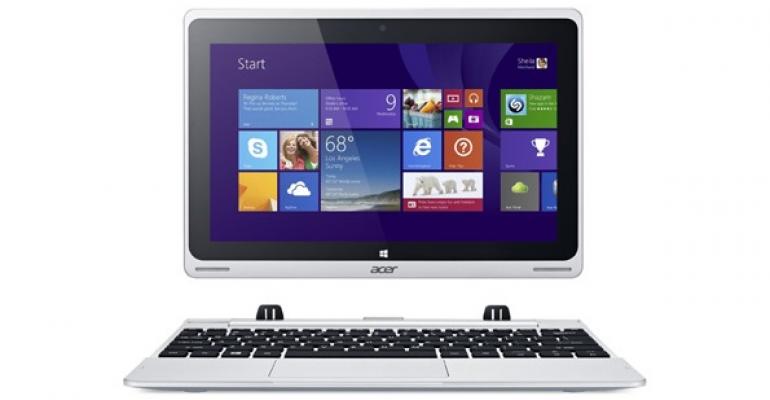Acer recently announced the Switch 12, a hybrid PC that appears to rival Surface Pro 3. But the firm is already selling a smaller version of this intriguing device called the Switch 10. So I'm going to take a peek at that before its bigger brother comes in for review.
I've been intrigued by the 2-in-1/hybrid category since Microsoft first started talking up Windows 8. And while there have been some highs and lows, I still feel like these types of PCs will eventually replace the traditional Ultrabook. What held them back so far, I think, was the immature first release of Windows 8 and of course a slew of not-quite-right transforming PC designs. But these issues have largely subsided. Windows 8 has morphed into the far more elegant Windows 8.1 with Update 1. And new PCs like Aspire Switch show a design maturity that evaded earlier 2-in-1s.

It's a cute little machine, and seeing it makes me even more eager to get my hands on the Aspire 12, which is coming soon. The specs are about what you'd expect: A quad-core Atom processor, 2 GB of RAM, 32 or 64 GB of internal storage, and a 10.1-inch screen that can be had in 1280 x 800 or 1366 x 768 resolutions. The review unit is the latter, and is a gorgeous IPS unit, and I recommend that as Windows will need to scale the display otherwise and none of you wants any part of that.
The review unit also came with the 64 GB storage option, and available free space out of the box was 42.8 GB out of 51.5 GB, with the rest taken up by a recovery partition.
The Aspire appears to solve two of the problems I've seen with many 2-in-1s. It's not particularly top-heavy when used in conjunction with its keyboard base, and the connection between the tablet/screen and that base appears to be solid. I'm actually kind of surprised by how far you can push back the tablet/screen when it's connected.

In fact, you can pop the tablet/screen off and put it on backwards, using the keyboard base in a tent or kiosk mode. So it's really a 4-in-1, or what we might simply call a hybrid PC. Take that, Yoga.

What's really neat about the design is that the tablet/screen just pulls off of the keyboard base with a bit off effort. It's basically magnet-based, with two positioning tabs, so you don't have to get a solid "click" to make the connection. It just connects automatically. So far, it seems to work really well.

This device also reminds me how much I prefer real hardware keyboards to the Surface Type Cover design. Yes, it's a bit heavier, and on the Aspire 10, the keyboard is not even full-sized.

Switch 10 compared to a full-sized mobile keyboard
But the heaviness of the base provides a more stable typing surface, and you can't beat a real clickpad. And it has a USB 2.0 port.

On the flipside, expansion is limited. The tablet/screen itself doesn't even offer a single full USB port, which is typically the set up with mini-tablets, not full-sized tablets. Instead, you get a micro-USB port (2.0, not 3.0), micro-HDMI, and a microSD slot.

The Acer Aspire Switch 10 weighs about 2.9 pounds, and it seems the tablet part of that is about half of that. Acer rates the device at 8 hours of battery life, but I'll test that of course.
The pricing certainly seems right. The review version of the Aspire Switch 10—with 64 GB of storage—is just $356 at Amazon.com right now. And the 32 GB version is only $270. And yes, those prices include the keyboard base, which is often a $100+ option on other devices.
More soon. But so far, I like what I see here quite a bit.





